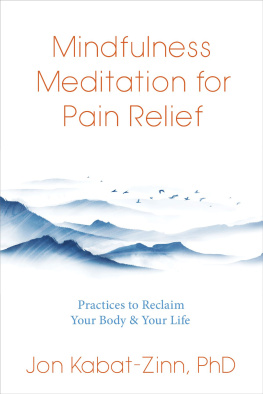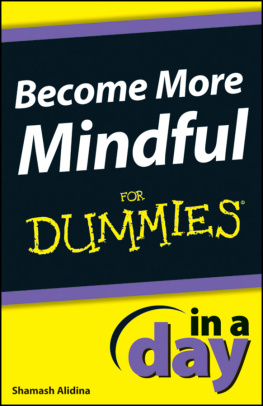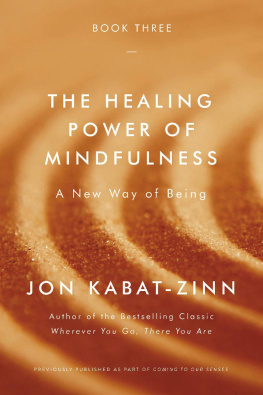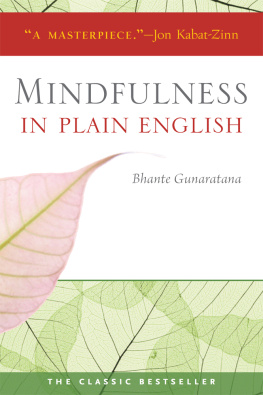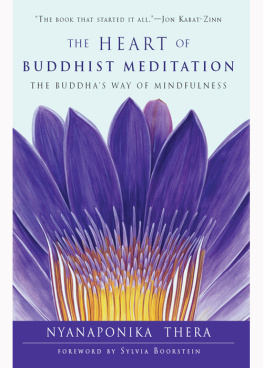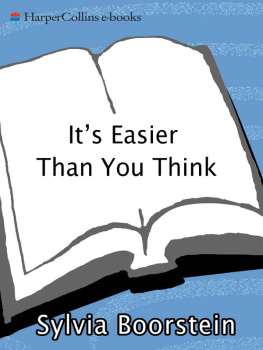In appreciation of mindfulness ,
and with gratitude for the
opportunity to practice, this book
is dedicated to you, the reader .
May your practice thrive .
May we all wake up .
May all beings be happy .
Preparing for the Retreat
When I was offered the opportunity to write this manual, I was delighted. Worrying arrived one moment later. Uh-oh, I thought, a manual usually prescribes things to do. Can I possibly say, Dont just do something, sit there?
I began to think of Buddhist rituals I know. Certain practice lineages contain ceremonies, prayers, and chants, quite lovely ones. Just as soon as I remembered them, though, I put them aside. In mindfulness practice, the only thing we add to current experience is calm attention.
Mindfulness, seeing clearly, means awakening to the happiness of the uncomplicated moment. We complicate moments. Hardly anything happens without the mind spinning it up into an elaborate production. Its the elaboration that makes life more difficult than it needs to be.
I discovered my habit of transforming neutral fact into painful opinion many years ago when I phoned a monastery to arrange to do a private retreat. The person I spoke with said, You need to talk to Robert, the retreat master. I left a message for Robert and was assured he would call me back. The following day I had a message on my answering machine from Robert saying he was returning my call. The day after that, I phoned and was told, once again, that Robert wasnt there. I explained that I had called Robert and Robert had called me and here I was, now, calling Robert again. I added, embroidering the situation, Maybe this is a sign that Im not supposed to do my retreat there. The response I got was, I think its just a sign that Robert isnt here. I had complicated my moment.
Mindfulness practice is the habit of seeing things in an uncomplicated way. You do not need to wait until a retreat time to start practicing. Nor do you need to go away to do your retreat. If you can easily negotiate a supportive retreat space, thats great. It is helpful to be away from familiar diversions and to have some seclusion. But if going away is not an option, you can do a retreat at home by ignoring familiar diversions, unplugging the phone, and posting a sign: Three-Day Retreat in Progress.
Retreat practice starts before the retreat. It begins with the decision to practice, with the intention to be mindful. You have already started.
You can practice mindfulness without any concern about compromising your religious beliefs or affiliations. It is true that the Buddha had a cosmology that might be different from yours, and it is true that the Buddha taught mindfulness as a main practice, but he didnt teach that cosmology and mindfulness were interdependent.
One famous Buddhist story describes a novice monk complaining to the Buddha that he had not been given enough cosmological answers. (Imagine! Complaining to the Buddha! ) In the story, the Buddha agrees with the novice but says that intellectual formulations are not what end suffering. To illustrate this point, he gives a hypothetical example in which a person shot with a poisoned arrow discusses the particulars of the shooting before having the arrow removed. Removing the arrow, not discussing the shooting, is the way to address the persons suffering. A contemporary Buddha might use the example of a person who is injured in an accident, then whisked away by paramedics to an emergency room. The injured person does not stick around to discuss the particulars; the police can do that. Directly addressing the suffering is clearly the wisest response.
The Buddha taught that mindfulness is the direct antidote to suffering because it leads to wisdom. I like to think of mindfulness practice as a way of becoming wise and being wise at the same time.
The becoming wise part is a gradual process. By paying attention calmly, in all situations, we begin to see clearly the truth of life experience. We realize that pain and joy are both inevitable and that they are also both temporary. We remember, more and more often, that struggling causes suffering and that compassionate, considered responses make life manageable. Sometimes we forget. The long-term goal of practice is to never forget.
The being wise part of mindfulness practice happens as we act now, in this very moment, on the way to never forgetting. Mindfulness practice cultivates the habit of not getting angry with life because it isnt happening in the way wed like. Unpleasant situations call for balanced responses. Anger is extra. Mindfulness practice also cultivates the habit of enjoying pleasant experiences while they last without lamenting their passing. Camera film ads notwithstanding, we cannot capture the moment. Mindfulness practice means acting as if we were already enlightened.
My friend Jean told me that she had discovered a large hornets nest under the eaves of her roof. Her eight-year-old granddaughter, Courtney, who was with her at the time, was frightened and didnt want to stay outside. Jean, too, was dismayed by the presence of so many hornets and paused to consider possible remedial alternatives.
Sensing her grandmothers reluctance to take immediate action, Courtney asked, What are you waiting for?
Im thinking, Jean replied. I dont like having these hornets here either, but Buddhists dont like to harm living beings
Courtney looked up at Jean with the sideward, skeptical look children have when they think someone might be teasing them. Finally, she shook her head in disbelief. Naah, she said. Nobody s grandmother is a Buddhist.
I think what Courtney meant was, Hey, you cant change cultural contexts on me all of a sudden! Practicing mindfulness does not mean becoming a Buddhist. It means living like a Buddha.
The Buddha didnt teach very much meditation. Mostly, he taught about suffering. He showed how the mind becomes confused and fatigued chasing pleasant experiences and running away from unpleasant experiences. Pleasant and unpleasant experiences, the joys and pains of everyones life, are not, he explained, the problem. Its the chasing and running that creates tension in the mind. That tension is what the Buddha called suffering.
Some people, when they heard the Buddha teach, understood him so completely that all their mind habits of chasing and running (which are called clinging and aversion in formal scripture language) stopped forever. They were called arahats fully enlightened beings. For everyone else, the Buddha taught special practices.
The principal meditative practice the Buddha taught is called mindfulness : relaxed, nonclinging, nonaversive awareness of present experience. You could think of it as a natural capacity that, like any other skill, requires developing. A retreat provides a special opportunity to practice.
The instruction manual that the Buddha wrote for mindfulness practice is a sermon called The Foundations of Mindfulness. I reinspire myself each time I read the opening paragraph: This is the sole wayfor the overcoming of sorrow and lamentation, for the destroying of pain and grief. Thats such an exciting possibility.
The rest of the sermon is the Buddhas instruction guide for the four ways to pay attention. This manual, like the Buddhas, will include all four of these methods in what is, basically, a practice of attentive sitting and alert walking.
Mindfulness is like other skills that become effortless and automatic with practice. I can knit and think at the same time, without dropping stitches. My friend Alta used to be able to knit in the movies. At the beginning of meditation practice you need to remember to be mindful. After a while, you cant forget.



